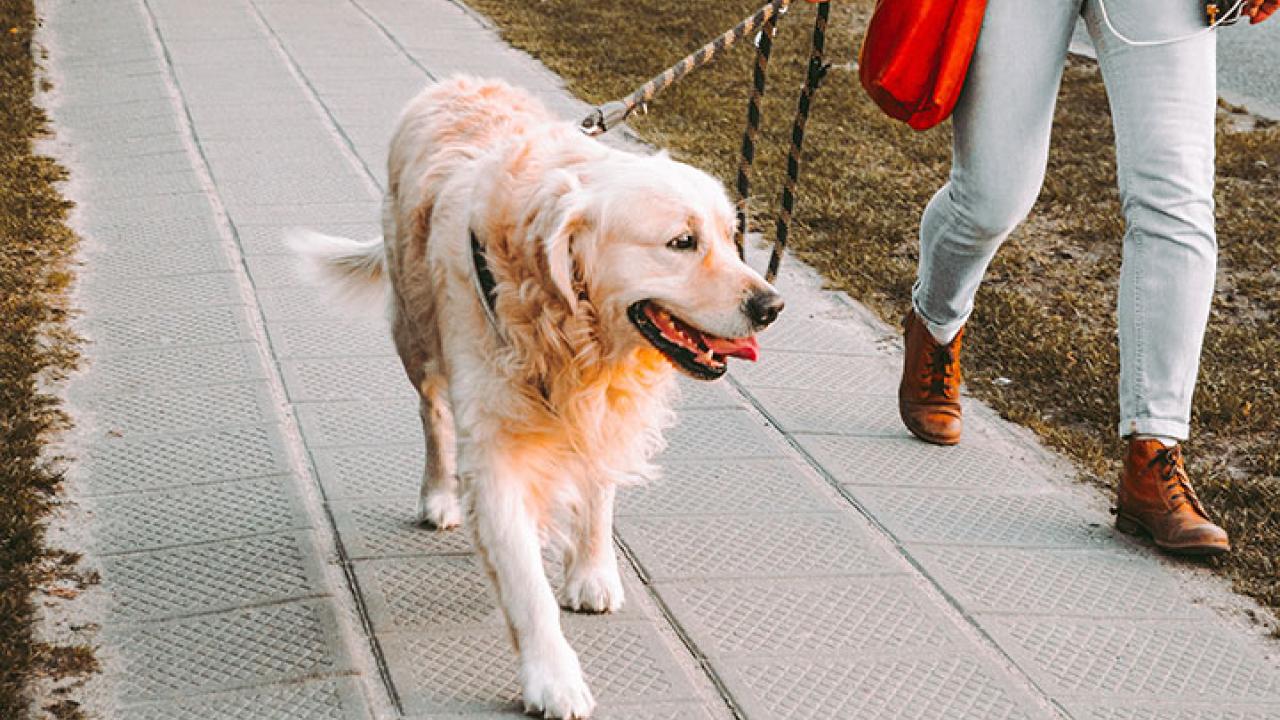
Loose Leash Walking
Loose Leash Walking
How we can help
Call 530-752-1393 to schedule an appointment with the Behavior Service.
A dog may pull on his or her leash for many reasons, but the most common cause is lack of proper training. An owner may encounter difficulties in training certain breeds such as sled, working, or tracking dogs that were bred to pull. Dogs that exhibit fear, anxiety or aggression will need to see a veterinary behaviorist for assessment; these issues need to be addressed separately prior to training.
Is positive or negative reinforcement for me? At UC Davis we teach a combination of positive and negative reinforcement as the best tools for learning.
- What is positive reinforcement? Adding something that is likely to make the dog repeat the behavior. An example would be rewarding a desired behavior such as walking nicely by your side with praise, petting, or treats.
- What is negative reinforcement? Taking away a negative stimulus when a correct behavior is performed. An example may be something as simple as relief of pressure on the neck when a dog stops pulling.
- What is positive punishment? Positive punishment is adding a stimulus to decrease the likelihood of an action from happening. We don’t recommend positive punishment because it breaks the human-animal bond.
Controlling the Behavior
Here is a short list of tools that you can use to control leash pulling. Each tool has its advantages and disadvantages.Dogs also require some form of training to walk well on-leash.
| Tool | Advantage | Disadvantage |
|---|---|---|
| Head collars (i.e. Gentle Leader ®, Halti ®) | Controls head using pressure points | May be mistaken for a muzzle. Dog may need to gradually get used to wearing it. |
| Front attachment harnesses (i.e. Easy Walk Harness ®) | Front chest leash attachment decreases pulling | Some dogs still pull |
| Flat collar | Easy to use | Dog can still pull |
| Choke/training collar | None, unless dog is highly trained to use it | Difficult to use correctly. Can cause neck injury if used improperly. Dog can still pull. |
| Prong/pinch collar | Potentially easy to use | Difficult to use correctly. Can cause neck injury if used improperly. Works by instilling pain when pulling. Must fit correctly to use properly. Dog can still pull. |
Correcting the Behavior
Some methods to train a dog to walk by your side with a loose leash are listed below. For all training, you should reward the dog when he is doing something you want, instead of just telling him what you don’t want. Training can be a long process; these methods require consistency and perseverance. Training sessions should begin after your dog has had sufficient exercise and not as a substitution for exercise. Don't give up!
- Reward your dog when he is not pulling
Start with your dog in a quiet area. Walk your dog on leash. When your dog is walking next to you for 2 steps, give a treat. Gradually increase the amount of walking and distractions. The idea is to catch your dog doing something right and reward that behavior. - The “Tree Method”
When your dog pulls, become an immobile object. Once your dog stops pulling and the leash is relaxed, call the dog to your side and praise or give a treat. This reinforces the positive behavior of maintaining a loose leash. - Walking the Other Way
In order to reinforce a dog’s natural tendency to follow, once your dog pulls out in front, you should turn quickly and walk the other way. Reward once you feel slack on the collar. This can cause a walk to go no more than a few feet at the beginning, so be patient. The pull back should only be strong enough to get your dog’s attention. Excessive force, especially when using choke chains, may cause neck trauma.
For more information, please contact your veterinarian or a trainer who uses humane training methods.
*This article may not be reproduced without the written consent of the UC Davis School of Veterinary Medicine.
